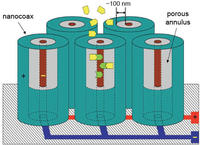-
Math tree may help root out fraudsters
Fraudsters beware: the more your social networks connect you and your accomplices to the crime, the easier it will be to shake you from the tree — the Steiner tree, that is; a new study outlines the connection linking fraud cases and the algorithm designed by Swiss mathematician Jakob Steiner
-
-
Netanyahu cancels security cabinet meeting on Iran after leaks

Israel’s prime minister, Benjamin Netanyahu, scheduled a 2-day marathon meeting of Israel’s security cabinet for Tuesday and Wednesday, with an 8-hour session planned for each day; the 2-day meeting was called for a thorough and comprehensive – and probably decisive — discussion of Iran’s nuclear weapons program and what should Israel do about it; the speakers on Tuesday included the directors of Israel’s military and civilian intelligence agencies; early Wednesday, Netanyahu abruptly canceled the meeting’s second session because of leaks from Tuesday top-secret meeting session appeared in the Israeli press
-
-
DHS funds more tests of autonomous power buoy for ocean surveillance

Ocean Power Technologies (OPT) has entered into an agreement with DHS Science & Technology Directorate to perform a new round of in-ocean tests on the company’s Autonomous PowerBuoy to demonstrate its use for ocean surveillance
-
-
Cloud OS for the U.S. intelligence community
Cloud management specialist Adaptive Computingis partnering with the investment arm of the CIA, In-Q-Tel, to develop a cloud operating system for use by U.S. intelligence agency
-
-
Powerful new explosive could replace today's state-of-the-art military explosive
Borrowing a technology used to improve the effectiveness of drugs, scientists are reporting discovery of a new explosive more powerful than the current state-of-the-art explosive used by the military
-
-
Assassination attempt on Quebec’s premier-elect foiled
A man shouting “The Anglos are waking up” broke into a victory party held by Pauline Marois, Quebec’s premier-elect and the leader of the separatist Parti Quebecois (PQ), after the party won the provincial election on Tuesday; the gunman missed Marois but killed one man and wounded two others; the PQ emerged as the largest party in the province, but it failed to win an outright majority; its minority government status means that it will not be able to push for a referendum on Quebec’s independence from Canada
-
-
Law-enforcement agencies eager for Web-surveillance tools

Private technology firms are pitching software capable of analyzing large swaths of the Internet to local law enforcement looking for ways to stop the next mass shooting or domestic terrorist event before it happens; police departments hope the software will help them detect online information from terrorists, traffickers, pedophiles, and rioters
-
-
As shoe-scanning devices fail, passengers continue to remove their shoes

In the last five years the U.S. government has tested several scanning devices for detecting explosives and other weapons concealed in the shoes of airline passengers; after spending millions of dollars on these devices, TSA has concluded that the detection systems are ineffective; the result: removing shoes at security check points is going to be a part of air travel for the foreseeable future
-
-
Drones being used to track hurricanes

Federal hurricane trackers will start experimenting with unmanned boats and aircrafts to learn more about how to anticipate and track the movements of hurricanes; NASAand the National Oceanic and Atmospheric Administration(NOAA) are teaming up and using a pair of military-surplus Global Hawk spy drones, which are known more for spying on battlefields than chasing storms
-
-
The costs, benefits, and efficiency of aviation security measures
The threat of terrorist attack on American aviation has made the system the focus of intense security efforts, but it is difficult to determine if the benefits outweigh their cost; efficient security policy — a focus on getting the most security for the least cost — should be the priority in an era of fiscal austerity, says a new RAND report
-
-
Near-instantaneous DNA analysis
Polymerase chain reaction (PCR) is an indispensible technique allowing researchers and clinicians to produce millions of copies from a single piece of DNA or RNA for use in genome sequencing, gene analysis, inheritable disease diagnosis, paternity testing, forensic identification, and the detection of infectious diseases; PCR for point-of-care, emergency-response, or widespread monitoring applications needs to be very fast — on the order of a few minutes; this has now been achieved
-
-
Alcatel-Lucent offers first-responders access to multiple video feeds using 4G LTE
New first responder video solution provides mission-critical information on handheld devices to fire, police, and ambulance services to improve responsiveness, safety, teamwork, and cost efficiency; the First Responder Video solves the network congestion problem by optimizing bandwidth use and integrating multiple video feeds and other operational data into one single stream
-
-
Photographers and security personnel fight over access to buildings
In the years after 9/11 and the 7 July 2005 London bombings, photographers have been waging a war with security personnel of public and private buildings; photographers argue that anything that one can see from the street can be photographed, even if it is a privately owned building, but security people – both private and the police – are worried about terrorists gathering information for a possible attack
-
-
DHS using Boston subway system to test new sensors for biological agents

Bioterrorism is nothing new, and although medicines have made the world a safer place against a myriad of old scourges both natural and manmade, it still remains all too easy today to uncork a dangerous cloud of germs; DHS’s Science and Technology Directorate (DHS S&T) has scheduled a series of tests in the Boston subways to measure the real-world performance of new sensors recently developed to detect biological agents
-
-
New camouflage makeup shields soldiers from searing heat of bomb blasts
The new camouflage makeup protects the face and hands for up to fifteen seconds before its own temperature rises to the point where a first-degree burn, which is a mild burn, might occur; in some tests, the new face paint can protect for up to sixty seconds, which could be important in giving soldiers time to move away from blast-related fires and also for use by civilian firefighters
-
More headlines
The long view
Why Ukraine’s AI Drones Aren’t a Breakthrough Yet
Machine vision, a form of AI, allows drones to identify and strike targets autonomously. The drones can’t be jammed, and they don’t need continuous monitoring by operators. Despite early hopes, the technology has not yet become a game-changing feature of Ukraine’s battlefield drones. But its time will come.
